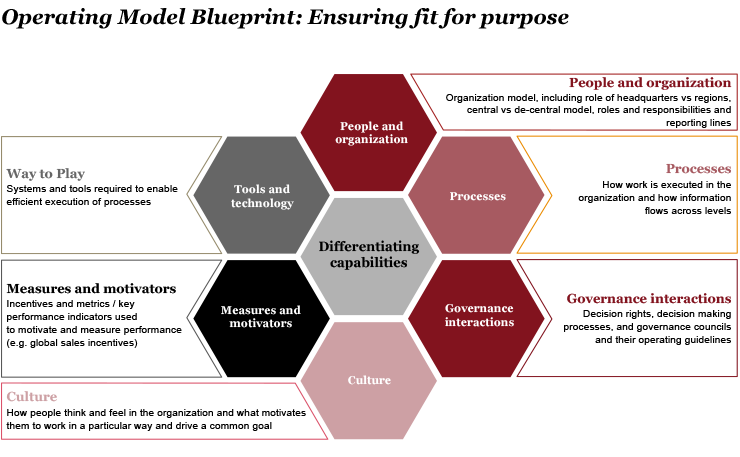{{item.title}}
{{item.text}}

Download PDF - {{item.damSize}}
{{item.text}}
“A company with a strong alignment between its strategy and its operating model is like an engine firing on all cylinders.”
Building a strategically aligned, “fit for purpose” operating model continues to be an elusive goal for many companies. They may be struggling with the symptoms of an underperforming operating model, including business units and functions that protect their own domain’s priorities to the detriment of the overall business, hoarded or wasted resources, strategic goals without follow-through, and a culture that dismisses or ignores accountability.
Among other things, an operating model determines behavior, workflow and process design, IT decisions, and investment decisions. When a company’s operating model is inconsistent with the broader objectives of the business, that misalignment affects the day-to-day actions of individual employees and ultimately creates an insurmountable gap between strategy and execution.
Companies with a Capabilities-Driven Strategy have a great starting point for developing their operating model because they have clarity about the “what” (the way the company creates value through its differentiating capabilities) and can therefore define the “how” (the way to organize to create value).
At Strategy&, we recommend starting with a Capabilities-Driven Strategy to establish clarity about the “what” (the way a company creates value through its differentiating capabilities) before defining the “how” (the way to organize to create value). After that’s in place, we work with clients to develop an operating model that brings their strategy to life, by determining the organizational imperatives for:
We then develop an operating model blueprint that puts differentiating capabilities at the heart of key organizational elements and develop a roadmap for change.
In turbulent times, your strategy matters more than ever. The world's greatest companies weather adversity and uncertainty much more adeptly by operating from their core strengths. A strategy built on these differentiating capabilities helps you outpace the competition, achieve faster growth, and earn the right to win.
Far too many strategies fail when it comes time to bring them to life. In fact, more than two-thirds of executives say they don’t have what they need to execute their strategy. Find out how your company can avoid falling into the strategy-through-execution gap by asking 3 questions.
Supercompetitors have a special recipe for success. It’s fueled by capabilities and it makes these iconic companies so powerful that they’re actually influencing and reshaping entire industries. Find out how you can use smart strategy to transform your future.
Discover how to change the future

